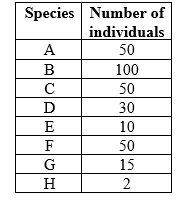Refer to the table.
Table 4
 Determine the structure of the energy pyramid for your study area. Use the numbers of individuals of each species in Table 4 (for this question, do not include the omnivorous species). Assume that all individuals of all species have the same biomass.
Determine the structure of the energy pyramid for your study area. Use the numbers of individuals of each species in Table 4 (for this question, do not include the omnivorous species). Assume that all individuals of all species have the same biomass.
a) Collect the data you would need to construct the energy pyramid from Table 4 and use it to create a new table (this will be referred to as Table 5). The columns should be category, number of individuals, number of half the individuals (negative), and number of half the individuals (positive). Under the category column should be the following rows: primary producers, herbivores, primary carnivores, and secondary carnivores. Fill in the rest of the table.
b) Use these data to graph the energy pyramid for your study area (this will be referred to as Figure 3). To aid in creating the graph, once you have determined the total number of individuals in each category, divide the number of individuals by half. One half will be plotted on the left of the graph (as negative) and one half will be plotted on the right of the graph (as positive). Your graph should be centered around a y-axis at 0. Label each step in the energy pyramid with the category name (e.g., herbivores) from the table.
c) Based on Figure 3, what type of ecosystem are you studying?
Definitions:
Q6: An experimental design includes:<br>A) manipulation of two
Q6: Which statement about zero population growth isoclines
Q7: Collaboration requires:<br>A) controlled communication.<br>B) respect for each
Q16: If another predator were to begin
Q20: In experiments measuring the NPP of grassland
Q42: Refer to the table.<br><img src="https://d2lvgg3v3hfg70.cloudfront.net/TBO1115/.jpg" alt="Refer to
Q49: Refer to the figure.<br><img src="https://d2lvgg3v3hfg70.cloudfront.net/TBO1115/.jpg" alt="Refer to
Q56: The total amount of photosynthesis is referred
Q64: Refer to the table.<br>Table 1<br> <img src="https://d2lvgg3v3hfg70.cloudfront.net/TBO1115/.jpg"
Q73: A bee pollinating an important agricultural crop